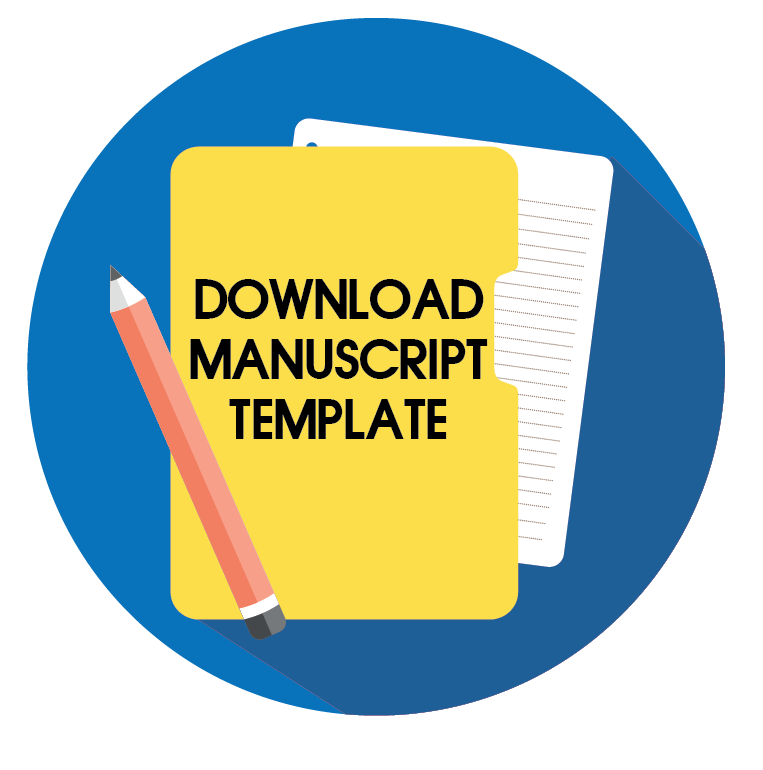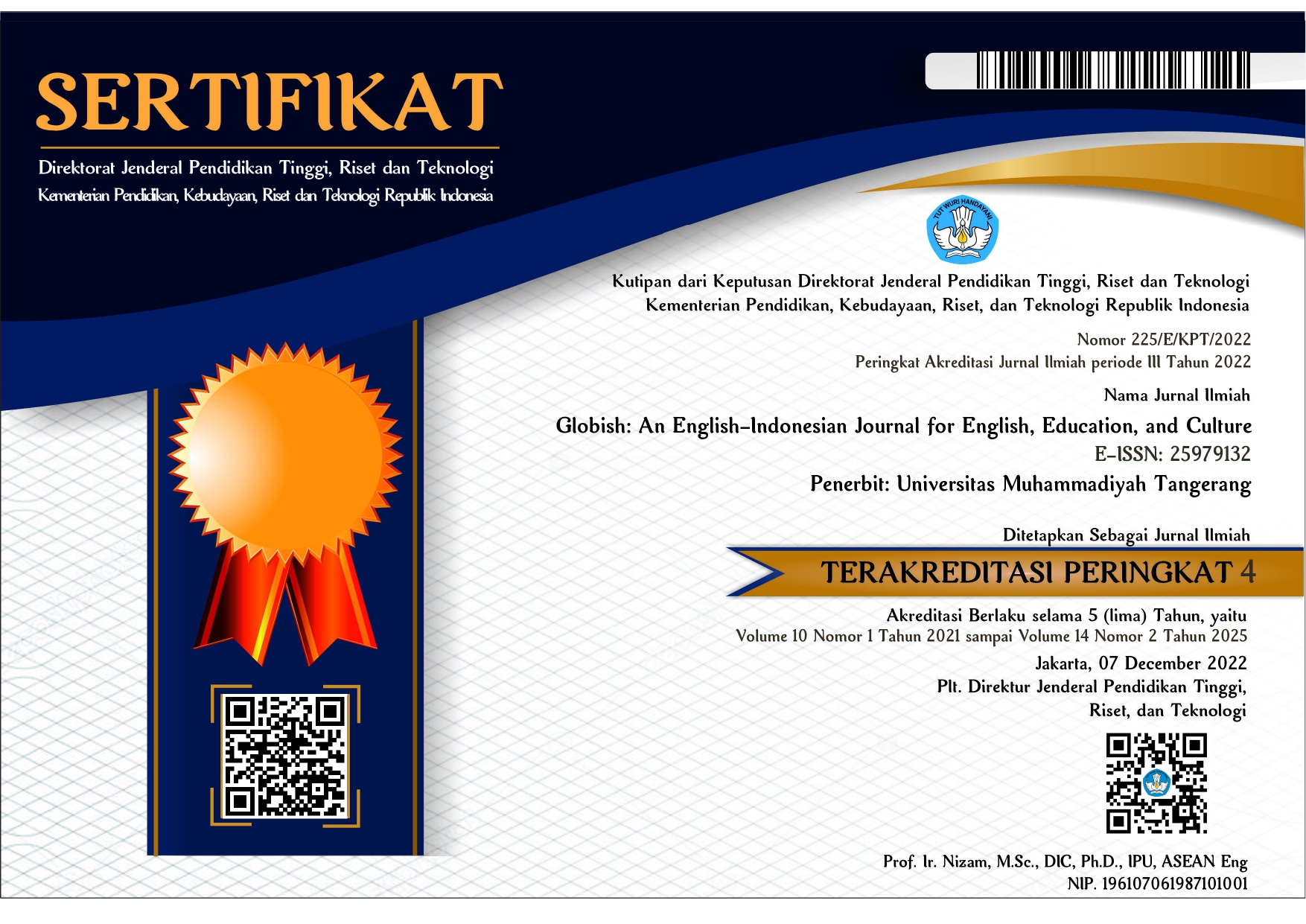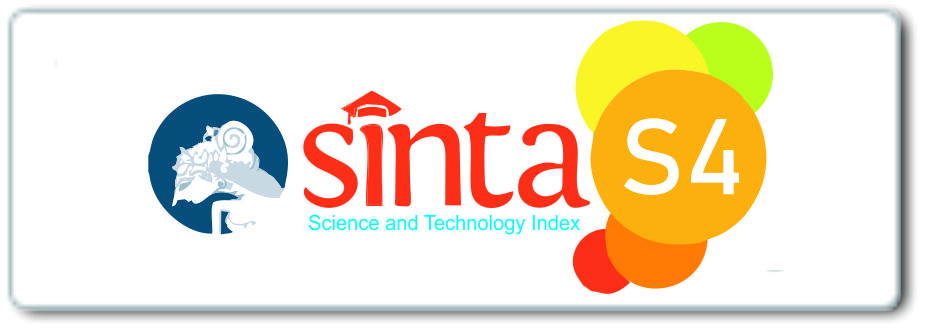Canva Talking Presentation In Enhancing Speaking Proficiency: Students’ Perceptions
Abstract
This study aimed to explore students’ perceptions regarding the implementation of Canva talking presentation as a digital language learning tool. It adopted a case study design to respond the research problem with mixed-method approach. A questionnaire consisted of 27 statements was used to collect quantitative information focuses on students' opinions of Canva talking presentations in learning. Additionally, qualitative methods as interviews were used to understand students' experiences with Canva talking presentations, exploring the causes, challenges, and overall learning process. The study employed 28 students as participants. The study found that 82.2% of students were motivated to improve their English, and 85.7% felt more confident. Most students mentioned the project helped improve their vocabulary (82.1%) and overall English skills (96.4%). Canva Talking Presentation helps improve students' speaking skills but needs some adjustments. Students faced issues with technical problems, pronunciation, grammar, and repeating to be accurate, showing areas to improve.
Keywords: canva talking presentation, speaking skills, students’ perception
Keywords
Full Text:
PDFReferences
Abbasova, M., & Mammadova, N. (2019). The Role of Digital Technology in English Language Teaching in Azerbaijan. International Journal of English Linguistics, 9(2), 364. https://doi.org/10.5539/ijel.v9n2p364
Akella, D. (2010). Learning together: Kolb’s experiential theory and its application. Journal of Management and Organization, 16(1), 100–112. https://doi.org/10.5172/jmo.16.1.100
Anggini, D., & Arjulayana. (2021). Analysis Student’s Speaking Performance as a Public Speaker. Globish (An English-Indonesian Journal for English, Education and Culture), 10(1), 60.
Ayuningtyas, F. M., & Wiyanah, S. (2023). Teacher’S Methods in Teaching Integrated Listening and Speaking At English Department. Globish: An English-Indonesian Journal for English, Education, and Culture, 12(2), 130. https://doi.org/10.31000/globish.v12i2.8693
Candra, R. M. A., Chandra, N. E., & Hidayat, F. (2022). the Use of Canva Application in Creative Writing Course : Students ’ Perceptions. InCoLLT, InCoLLT, 187–203.
Cohen, L., Manion, L., & Morrison, K. (2018a). Case studies. In Research Methods in Education. https://doi.org/10.4324/9781315456539-19
Cohen, L., Manion, L., & Morrison, K. (2018b). Research Methods in Education (8th Edition). In New York, Routledge.
Damayanti, M. E., & Listyani, L. (2020). An Analysis of Students’ Speaking Anxiety in Academic Speaking Class. ELTR Journal, 4(2), 152–170.
Dewi, R., & Zuniati, M. (2021). Speaking Students’ Worksheet Based on E-Book. Jurnal of English Development, 1(4), 35–44. https://doi.org/10.22141/2224-0721.16.4.2020.208486
Endahati, N., & Wardani, S. (2023). Using Augmented Reality technology to improve English language learning by identifying objects around us. … Teaching Educational Journal, 6(1), 73–83. http://www.journal2.uad.ac.id/index.php/eltej/article/view/6497%0Ahttp://www.journal2.uad.ac.id/index.php/eltej/article/download/6497/3895
Fauzi, I. (2024). The Effectiveness of Using Canva as Assisted Language Learning Media to Improve Undergraduate Students’ Writing Skill. Globish: An English-Indonesian Journal for English, Education, and Culture, 13(2), 230. https://doi.org/10.31000/globish.v13i2.10148
Fauziyah, N. L., Widodo, J. P., & Yappi, S. N. (2016). The Use of ‘ Canva for Education ’ and the Students ’ Perceptions of Its Effectiveness in the Writing Procedure Text. 6368–6377.
Franscy, F., & Ramli, R. (2022). Problems Encountered by Indonesian EFL Learners in Mastering Speaking Skills. Pioneer: Journal of Language and Literature, 14(1), 1. https://doi.org/10.36841/pioneer.v14i1.1176
Grace Hui Chin Lin. (2008). Pedagogies Proving Krashen’s Theory of Affective Filter. Hwa Kang Journal of English Language & Literature, 14, 113–131. https://www.researchgate.net/publication/279436691
Hamad, M. M., Metwally, A. A., & Alfaruque, S. Y. (2019). The Impact of Using YouTubes and Audio Tracks Imitation YATI on Improving Speaking Skills of EFL Learners. English Language Teaching, 12(6), 191. https://doi.org/10.5539/elt.v12n6p191
Handayani, I., Rahmawati, E., & Nurlely, L. (2022). a Critical Review on the Discussion of Developing Speaking Skills Through Task Based Materials. Indonesian EFL Journal, 8(2), 277–286. https://journal.uniku.ac.id/index.php/IEFLJ/article/view/6489
Jaya, H. P., Petrus, I., & Pitaloka, N. L. (2022). Speaking Performance and Problems Faced By English Major Students at A University in South Sumatera. Indonedsan EFL Journal (IEFLJ), 8(1), 105–112.
Kurniawan, D. B. (2019). Pemanfaatan Canva Sebagai Media Pembelajaran Interaktif dalam Meningkatkan Pemahaman Peserta Didik SD Negeri Sudimara pada Mata Pelajaran Bahasa Inggris. Journal Elementary, 2(1), 40.
Larasati, M., & Rustandi, A. (2022). Empowering Student’S Creative Writing Ability By Using Canva (a Case Study Research in One Junior High School in Ciamis). JEEP: Journal of English Education Program, 9(2), 101–110. https://jurnal.unigal.ac.id/index.php/jeep
Lastari, D. S., Putra, A. S., Putra, A. S., & Rohim, A. (2024). Investigating the Utilization of TikTok Application to Improve Nursing Students’ English Speaking Skills. Globish: An English-Indonesian Journal for English, Education, and Culture, 13(1), 81. https://doi.org/10.31000/globish.v13i1.10544
Lestari, I. P. (2021). Students’ Perception On Video Project As An English Speaking Assessment Thesis.
Mafiroh, R., Agustina, S., Megawati, F., & Phumphanit, Y. (2024). Cooperative Learning Using Canva to Boost Speaking Activities in a Primary School. Journal of Languages and Language Teaching, 12(2), 723. https://doi.org/10.33394/jollt.v12i2.10455
Miliszewska, I., & Horwood, J. (2006). Engagement theory. ACM SIGCSE Bulletin, 38(1), 158–162. https://doi.org/10.1145/1124706.1121392
Nabavi, R. T., & Bijandi, M. S. (2024). A literature review on Bandura ’ s Social Learning Theory & Social Cognitive Learning Theory. January 2012.
Nanda, M., & Fatimah, S. (2023). Students ’ Perception of Canva as A Media In Learning English : A Descriptive Study at SMA N 6 Sijunjung. Journal of English Language Teaching, 12(1), 176–187. https://doi.org/10.24036/jelt.v12i1.121625
Nguyen Vo Bich, N., & Nguyen, A. (2024). The utilization of the Canva application for enhancing speaking skills among non-English major students at The People’s Police College II. Journal of Knowledge Learning and Science Technology ISSN: 2959-6386 (Online), 3(2), 119–127. https://doi.org/10.60087/jklst.vol3.n2.p127
Nunan, D. (2003). Practical English Language Teaching. McGraw-Hill.
Nunan, D., Terrell, T. D., & Brown, H. D. (2003). Practical English Language Teaching. In Language (Vol. 57, Issue 3).
Nurhidayat, E. (2021). Utilizing Canva As Digital Tools To Teach Grammar in Remote Learning Period. Journal of English Language Learning, 5(2), 95–99. https://doi.org/10.31949/jell.v5i2.3413
Nyoman, S. (2023). The Implementation of Canva as a Media for Learning English at SMK Negeri 2 Singaraja. International Journal of English Education and Linguistics (IJoEEL), 5(1), 84–94. https://doi.org/10.33650/ijoeel.v5i1.5482
Pahmi, P., Jufri, S., & Fajri, S. (2023). Use of Presentation Applications as Learning Media. Al-Hijr: Journal of Adulearn World, 1(1), 30–39. https://doi.org/10.55849/alhijr.v1i1.501
Pelangi, G. (2020). Pemanfaatan Aplikasi Canva Sebagai Media Pembelajaran Bahasa Dan Sastra Indonesia. Jurnal Sasindo Unpam, 8(2), 79–96.
Priyatna, I. P. D., Suwastini, N. K. A., & Dantes, G. R. (2023). College Students’ Perception of Using Canva in English Writing Class. Indonesian Journal Of Educational Research and Review, 6(1), 9–17. https://doi.org/10.23887/ijerr.v6i1.57231
Rahmatullah, R., Inanna, I., & Ampa, A. T. (2020). Media Pembelajaran Audio Visual Berbasis Aplikasi Canva. Jurnal Pendidikan Ekonomi Undiksha, 12(2), 317–327.
Richard, J. C. (2008). Teaching Listening and Speaking From Theory to Practice, available on: www. finchpark. com/courses/tkt/Unit_07. Richards-Teaching-Listening-Speaking. Pdf, 1–37.
Salam, M. Y., & Adam Mudinillah. (2021). Canva Application Development for Distance Learning on Arabic Language Learning in MTs Thawalib Tanjung Limau Tanah Datar. JTP - Jurnal Teknologi Pendidikan, 23(2), 101–111. https://doi.org/10.21009/jtp.v23i2.20650
Saputro, A. D., & Harianto, J. (2023). Edukasi Pembuatan Desain Talking Presentation bagi Guru MA AL MUTTAQIN Buper Menggunakan Aplikasi Canva. Jurnal Inovasi Pengabdian Dan Pemberdayaan Masyarakat, 3(1), 325–330. https://doi.org/10.54082/jippm.77
Setianingsih, E., & Wiyanah, S. (2024). Visual Literacy: Comic Strips as Teaching Media in Simple Present Tense. 8(1), 1–17.
Seyyedi, K., Aminzadeh, S., & Omar, J. (2024). Focus on Form Approach in English Foreign Language Teaching. Zanco Journal of Humanity Sciences, 28(1). https://doi.org/10.21271/zjhs.28.1.7
Sherine, A., Seshagiri, A. V. S., & Sastry, M. M. (2020). Impact of whatsapp interaction on improving L2 speaking skills. International Journal of Emerging Technologies in Learning, 15(3), 250–259. https://doi.org/10.3991/ijet.v15i03.11534
Sosas, R. V. (2021). Technology in teaching speaking and its effects to students learning English. Journal of Language and Linguistic Studies, 17(2), 958–970. https://doi.org/10.52462/jlls.66
Sotlikova, R., & Haerazi, H. (2023). Students’ Perceptions Towards the Use of Podcasts in EFL Classroom: A Case Study at a University of Uzbekistan. Journal of Languages and Language Teaching, 11(3), 461. https://doi.org/10.33394/jollt.v11i3.8172
Suban, T. S. (2021). Teaching Speaking: Activities to Promote Speaking Skills in EFL Classrooms. Lectio, 41–50.
Supradaka. (2022). Pemanfaatan Canva Sebagai Media Perancangan Grafis. Ikraith-Teknologi, 6(74), 62–68.
Syaharuddin, S., Rusmaniah, R., Ilhami, M. R., Nursahid, N., & Uzhma, M. R. (2023). Making Animated Videos With The Canva Application As An Effort To Increase Student Motivation. Journal of Social Development, 1(2), 117. https://doi.org/10.20527/j-sod.v1i2.9608
Thomas, J., Condliffe, B., & Quint, J. (2000). Whatever Form a Project Takes , It Must Meet These Criteria To Be Gold Standard Pbl . Interdisciplinary Journal of Problem-Based Learning, 22(1), 1–18.
Tilana, F. P., & Dewi, D. N. (2024). Enhancing Students’ Literacy: Canva and Quizizz As Digital Multimodal Tools. English Review: Journal of English Education, 12(2), 463–474. https://doi.org/10.25134/erjee.v12i2.9578
Utami, Y., & Djamdjuri, D. S. (2021). Students’ Motivation in Writing Class Using of Canva: Students’ Perception. 15(2), 83–92.
Wahyuni, F., Riza, A., & Autila, R. (2022). Increasing Student’S Interest in Learning English Through Canva Application. Inovish Journal, 7(2), 159. https://doi.org/10.35314/inovish.v7i2.2600
Yundayani, A., Susilawati, & Chairunnisa. (2019). Investigating the Effect of Canva on Student’s Writing Skills. English Review: Journal of English Education, 7(2), 169–176. https://doi.org/10.25134/erjee.v7i2.1800.Received
Zahri, N. S., & Rahmawati, F. P. (2024). Strengthening presentation skills through TPACK-based canva media for elementary school students. Jurnal Fundadikdas (Fundamental Pendidikan Dasar), 7(1), 1–10. https://doi.org/10.12928/fundadikdas.v7i1.9878
DOI: http://dx.doi.org/10.31000/globish.v14i2.13087
Article Metrics
Abstract - 1467 PDF - 364Refbacks
- There are currently no refbacks.
Globish
Program Studi Pendidikan Bahasa Inggris
Fakultas Keguruan dan Ilmu Pendidikan
Universitas Muhammadiyah Tangerang
Jl. Perintis Kemerdekaan I/33, Cikokol
Kota Tangerang, Indonesia
e-mail: globish_journal@umt.ac.id
Globish (p-ISSN: 2301-9913 | e-ISSN: 2301-9913) is licensed under a Creative Commons Attribution-ShareAlike 4.0 International License.









